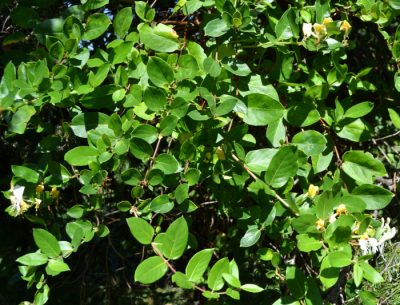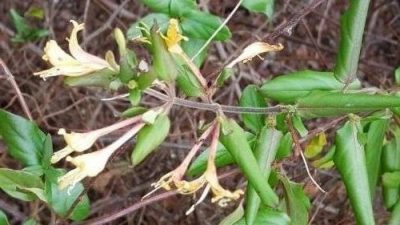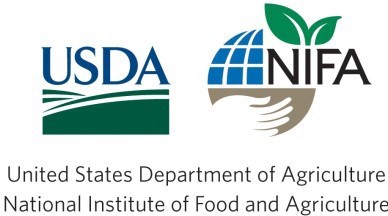Lonicera japonica
By Victoria Wallace, Alyssa Siegel-Miles, and Klaudia Sowizral, UConn Extension
Identifying Features
- OVERVIEW: Japanese honeysuckle is an aggressive invasive woody vine that climbs, suffocates, and strangles other plants. Vines can grow 80-120 ft. Deciduous in colder climates; evergreen in moderate to warmer areas.
- LEAVES: Opposite, ovate, 1.5-3 in long. Slightly glossy on upper sides of leaf, slightly hairy on underside. Margins are untoothed. Juvenile leaves may be lobed. Paired leaves are not fused at the stem.
- STEMS: Juvenile stems are reddish. Stems and petioles are variably pubescent (fuzzy). Older stems are hollow and brown, with bark that peels in strips. Stems can grow up to 2 in thick.
- FLOWERS: Tubular and bi-lobed (4 of the 5 petals are joined for most of their length above the flower tube). Occur in June-July. Flowers are fragrant, white, fading to yellow, and paired at the leaf axis (where leaf stem attaches to vine). Each pair of leaves has 2 flower stems, with 2 flowers each.
- SEEDS: Germinate after soil disturbance.
- FRUITS: Berries are dark purple to black. Fruiting occurs in September through November; fruits can persist through the winter. Each fruit is 2-3 mm wide and contains 2-3 seeds.
- REPRODUCTION/SPREAD: By seed, which are eaten and dispersed by birds and small mammals. Vines also reproduce vegetatively via underground shoots (rhizomes), sprouts from the root crown, and aboveground runners that root at the nodes and can grow more than 10 ft/year.


Native Alternatives and Look-Alikes
Coral honeysuckle (Lonicera sempervirens) is an excellent native alternative. Japanese honeysuckle has many look-alikes, which makes proper identification crucial. Common vining plants in the Lonicera genus, which can be mistaken for Japanese honeysuckle, include grape honeysuckle (L. reticulata), yellow honeysuckle (L. flava), hairy honeysuckle (L. hirsuta) and red honeysuckle (L. dioica). The common look-alikes feature clusters of many flowers, paired leaves fused at the stem, and bright red and orange fruit. Japanese honeysuckle can be differentiated by its dark colored fruits and the absence of any pairs of fused leaves.
Control
MECHANICAL CONTROL:
- Seedlings and small infestations may be hand-pulled. The entire root system must be removed to prevent regrowth.
- Pulling and digging are preferable prior to fruit production. Digging is most effective when the soil is moist. Frequent monitoring and repeated removal are necessary to prevent reestablishment. Note that pulling or digging plants causes soil disturbance, which can stimulate germination of the seed bank.
- Periodic mowing (at least twice a year, in mid-July and mid-September) may slow the plant’s spread. Vines can be cut to prevent climbing, girdling, and killing of any plants in which they are established. Avoid pulling cut vines if entangled in fine twigs. Note that cut plants will resprout; cutting or mowing may increase plant density if not supplemented with another form of control.
- For effective control, mechanical treatments should be supplemented with chemical control. Follow up treatments may be required for several years.
CHEMICAL CONTROL: Follow label instructions for any chemical application.
- A foliar spray of glyphosate or triclopyr can be applied from spring through fall. Repeat applications are often required. Treatment in the fall, after the first frost, when many non-target plants are dormant, is recommended.
- Cut stem treatment: A 25% glyphosate or triclopyr solution can be applied to cut stem surfaces any time of year as long as the ground is not frozen.
- Where foliage is evergreen in moderate and warm climates, there may be opportunity to apply herbicides in late fall or winter, when many native species are dormant. For effective herbicide control, healthy green leaves must be present at application time and temperatures must be sufficient for plant activity.
Refer to Plant Conservation Alliance’s Alien Plant Working Group for more details.

Distribution and Background

Japanese honeysuckle is widespread in the Eastern United States from Maine to Florida, as well as the Midwest, Southeast U.S., California, and Nevada. It was first introduced to the U.S. in Long Island, New York, in 1806, for its perceived ornamental, erosion control, and wildlife value.
Habitat
Japanese honeysuckle grows in a variety of soil conditions. It thrives in full sun and is also shade tolerant. It proliferates in disturbed areas, including fields, forests openings, and woodland edges. The fast-growing vine climbs surrounding trees and other vegetation, killing plants by girdling, smothering, or causing them to collapse under their weight. Japanese honeysuckle is sensitive to dry conditions and low temperatures, which may limit northern and westward spread.
SOURCES:
- Abbey, T. (Updated 2022, December 19). The Invasive Japanese Honeysuckle. PennState Extension. https://extension.psu.edu/the-invasive-japanese-honeysuckle
- Connecticut Invasive Plant Working Group. (n.d.). Japanese Honeysuckle (Lonicera japonica). https://cipwg.uconn.edu/japanese-honeysuckle/
- Munger, G. T. (2002). Lonicera japonica. Fire Effects Information System, U.S. Department of Agriculture, Forest Service, Rocky Mountain Research Station, Fire Sciences Laboratory. https://www.fs.usda.gov/database/feis/plants/vine/lonjap/all.html
- Plant Conservation Alliance’s Alien Plant Working Group. (2005, May 20). Fact Sheet: Japanese Honeysuckle. https://www.invasive.org/alien/fact/pdf/loja1.pdf
- University of Florida Institute of Food and Agricultural Science Center for Aquatics and Invasive Plants. (n.d.). Lonicera japonica: Japanese honeysuckle. https://plants.ifas.ufl.edu/plant-directory/lonicera-japonica/
Questions? Contact:
Vickie Wallace
UConn Extension
Extension Educator
Sustainable Turf and Landscape
Phone: (860) 885-2826
Email: victoria.wallace@uconn.edu
Web: ipm.uconn.edu/school
UConn Extension is committed to providing equal access and full participation for individuals with disabilities within all our programs and activities. Visit s.uconn.edu/accessibility for more resources. UConn is an equal opportunity program provider and employer.
©UConn Extension. All rights reserved.
Updated May 2022
  |